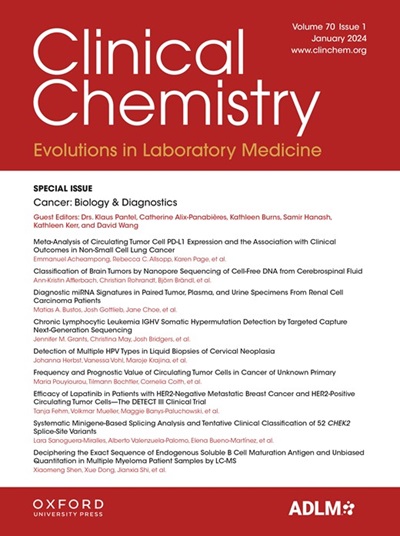B-013 Improving the Workflow of Blood and Coagulation Tests in clinical laboratory through the Utilization of Laboratory Automation Track Systems
IF 7.1
2区 医学
Q1 MEDICAL LABORATORY TECHNOLOGY
引用次数: 0
Abstract
Background The Laboratory Automation Track System (TLA) is an automated system designed for executing highly repetitive tasks within a laboratory, commonly applied in biochemical and immunological testing systems. It aims to reduce human errors in specimen handling, enhance the overall process quality, and provide better Turnaround Time (TAT) from specimen collection to result reporting. For the first time in our laboratory, we have integrated the blood and coagulation systems with TLA. Consequently, we seek to evaluate the differences in the testing workflow and reporting efficiency of the blood and coagulation systems after being connected to TLA. Methods Abbott GLP systems Track was the TLA system for connecting with blood and coagulation systems. Two Sysmex XN-9100 fully automatic hematology systems and two Sysmex CS-5100 fully automatic coagulation analyzers were developed for blood and coagulation system, respectively. TUNYEN Laboratory Information System was established for Laboratory information system (LIS). Results Through the analysis of quality indicators and integration with intelligent information systems, improvements have been made, including the reduction of blood collection tube usage, efficient manpower utilization management, tracking of specimen progress and achievement of timely reporting rates.(1)Approximately 2,915 blood collection test tubes are saved every month, with a converted cost of 0.15 USD per tube, and a total saving of 437 USD. And reduce the carbon emissions of 32 kgCO2e, comply with the spirit of ESG sustainable development.(2)The TLA no longer requires staff to collect and deliver specimens as in the past,reducing staff and enhancing work efficiency.One of manpower was saved and new inspection items were developed.(3)Tracking of specimen progress:The laboratory has set up a specimen tracking system to monitor the specimen delivery location and provide timely response to the clinical status.The one-hour TAT for blood and coagulation increased from 82.0% and 76.9% before improvement to 91.8% and 93.3% after improvement respectively. Conclusions The implementation of Laboratory Automation Track Systems (TLA) leads to a reduction in medical errors and specimen sample volume, while also enhancing accuracy and precision, thereby improving the safety of laboratory staff. Although the introduction of TLA may require an initial investment, it brings the benefits of automation, offering ease and efficiency to laboratory processes.B-013 利用实验室自动化跟踪系统改进临床实验室血液和凝血检验的工作流程
背景 实验室自动化跟踪系统(TLA)是为在实验室内执行高度重复性任务而设计的自动化系统,通常应用于生化和免疫测试系统。其目的是减少标本处理过程中的人为错误,提高整体流程质量,并缩短从标本采集到结果报告的周转时间(TAT)。我们实验室首次将血液和凝血系统与 TLA 集成在一起。因此,我们试图评估血液和凝血系统与 TLA 连接后在检测工作流程和报告效率方面的差异。方法 雅培 GLP 系统 Track 是连接血液和凝血系统的 TLA 系统。为血液和凝血系统分别开发了两套 Sysmex XN-9100 全自动血液分析系统和两套 Sysmex CS-5100 全自动凝血分析仪。为实验室信息系统(LIS)建立了统元实验室信息系统。结果 通过对质量指标的分析以及与智能信息系统的整合,在减少采血试管用量、高效的人力使用管理、标本进度跟踪和及时报告率等方面取得了改善。(2)TLA不再像过去那样需要工作人员采集和运送标本,减少了工作人员,提高了工作效率。(3)标本进度追踪:实验室建立了标本追踪系统,监控标本运送位置,及时反应临床状态,血液和凝血的一小时TAT分别从改进前的82.0%和76.9%提高到改进后的91.8%和93.3%。结论 实施实验室自动化追踪系统(TLA)可减少医疗差错和标本样本量,同时还能提高准确性和精确度,从而改善实验室工作人员的安全状况。虽然引进 TLA 可能需要初始投资,但它带来了自动化的好处,为实验室流程提供了便利和效率。
本文章由计算机程序翻译,如有差异,请以英文原文为准。
求助全文
约1分钟内获得全文
求助全文
来源期刊

Clinical chemistry
医学-医学实验技术
CiteScore
11.30
自引率
4.30%
发文量
212
审稿时长
1.7 months
期刊介绍:
Clinical Chemistry is a peer-reviewed scientific journal that is the premier publication for the science and practice of clinical laboratory medicine. It was established in 1955 and is associated with the Association for Diagnostics & Laboratory Medicine (ADLM).
The journal focuses on laboratory diagnosis and management of patients, and has expanded to include other clinical laboratory disciplines such as genomics, hematology, microbiology, and toxicology. It also publishes articles relevant to clinical specialties including cardiology, endocrinology, gastroenterology, genetics, immunology, infectious diseases, maternal-fetal medicine, neurology, nutrition, oncology, and pediatrics.
In addition to original research, editorials, and reviews, Clinical Chemistry features recurring sections such as clinical case studies, perspectives, podcasts, and Q&A articles. It has the highest impact factor among journals of clinical chemistry, laboratory medicine, pathology, analytical chemistry, transfusion medicine, and clinical microbiology.
The journal is indexed in databases such as MEDLINE and Web of Science.
 求助内容:
求助内容: 应助结果提醒方式:
应助结果提醒方式:


